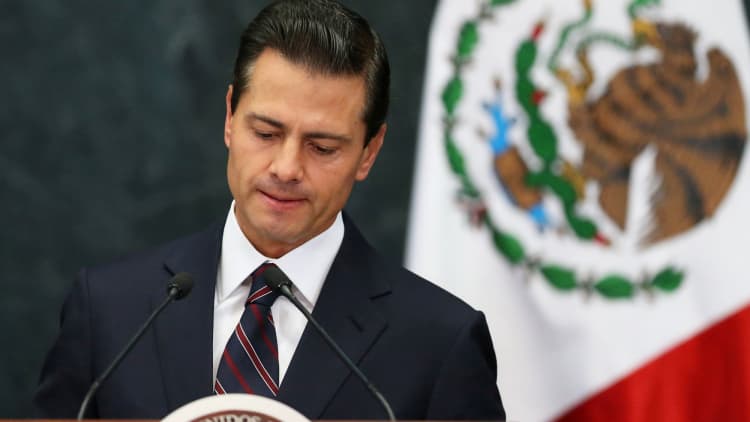
Twitter diplomacy just ripped the Mexican peso, again.
At its low, the currency was down more than a percent against the U.S. dollar after Mexican President Enrique Pena Nieto canceled a meeting with President Donald Trump, in a dispute over Trump's border wall. It later reversed some of the losses.
Pena Nieto was expected to visit the U.S. next week to discuss immigration and trade issues, and Mexican officials have been meeting with the Trump administration ahead of time. Though Trump seemed to make conciliatory comments about Mexico on Wednesday, the president reversed that sentiment by tweeting Thursday that the meeting should be canceled if Mexico won't agree to pay for the wall.
The Mexican president tweeted back, in Spanish, that he informed the White House that he would not be attending the meeting. White House spokesman Sean Spicer later said that the wall could be paid for with a 20 percent tax on all imports from Mexico, but the White House later backtracked and said the 20 percent tax was just an example of what could be done.

Trump signed two executive orders Wednesday aimed at cracking down on immigration, including a directive to build the wall. A barrier along the southern U.S. border was a key promise made by Trump during his campaign, and Mexican officials have repeatedly said they will not pay for it.
After Pena Nieto's tweet, the dollar moved higher against the Mexican currency. Dollar/peso rose to 21.30, after hitting 20.86 earlier in the day. The peso was down 1.1 percent against the dollar at midday but it recovered about a half percent in afternoon trading. The low for the peso was when it reached 22.0385 to the dollar on Jan. 11.
"Yesterday's conciliatory tone has been shattered by those tweets," said Andres Jaime, global foreign exchange and rates strategist at Barclays. "It's a reversal from yesterday's optimism that this was going to go smoother than initially thought. ... In the meantime, [the peso is] going to remain under pressure."
The talk of border tariffs reinforces the negative outlook for the peso, for now, said Win Thin, senior currency analyst at Brown Brothers Harriman.
"The market has gotten a little more balance, but I think it's (dollar) loaded for another move higher," said Thin. "I'm kind of confident that the dollar is going to head higher and I'm very confident we're going to have gyrations both ways...I still think things are negative for Mexico and nothing's changed. Tariffs are never good."
The peso recovered a bit after Spicer discussed a tax on Mexican imports but was still lower on the day. Jaime said he estimates the market is already pricing in a border tax, at about 16 percent, at current levels. "In our assumption expectations about Trump policy would imply a border tax of about 16 percent," Jaime said.
Jaime said he doesn't see the peso going much lower than it went in January, but he does expect it to be more volatile. He projects it to trade flat this year, but the risk would be more to the upside, because of the deep slide in the peso already.
"The U.S. has a huge trade deficit of $60 billion with Mexico, but it's very different, the relationship the U.S. has with Mexico than it has with China. [Trump] uses those headlines to tell the people, 'look, I'm doing what I promised,'" Jamie said. "We need to get used to this very high intraday volatility."
Markets had been looking forward to the meeting as the next event that could affect the peso, but now there's no event — other than tweets, which aren't predictable. "What we've seen, in terms of policy announcements, is many times you can see a tweet changes the perception of the market," he said.
The U.S. trade deficit with Mexico was about $58 billion in the first 11 months of 2016. It was $58 billion for all of 2015, according to Commerce Department data. The deficit was the largest in 2007, at $74.8 billion.
According to the Office of the U.S. Trade Representative, Mexico was the third-largest supplier of goods imported into the U.S. in 2015. The top category was vehicles, including parts at $74 billion. The U.S. also imports electrical machinery, mineral fuels, and optical and medical equipment. The U.S. imported $21 billion in agricultural products in 2015.



